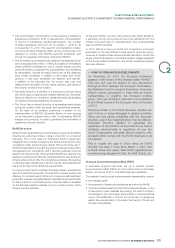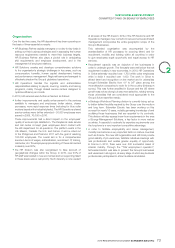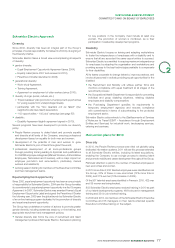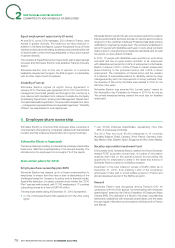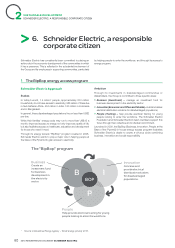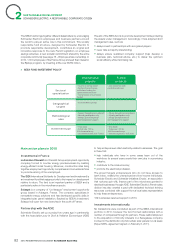APC 2010 Annual Report Download - page 77
Download and view the complete annual report
Please find page 77 of the 2010 APC annual report below. You can navigate through the pages in the report by either clicking on the pages listed below, or by using the keyword search tool below to find specific information within the annual report.
SUSTAINABLE DEVELOPMENT
COMMITTED TO AND ON BEHALF OFEMPLOYEES
3 Employee commitment
Within the Group, Schneider Electric is working to become the “best
company” to work for, as rated by its employees, and so every
quarter it conducts a survey of employee satisfaction.
Externally, it is looking to establish a strong name as an employer.
Schneider Electric Approach
Internally
Set up in 2009, the One Voice internal satisfaction survey is carried
out on a quarterly basis to take the organisation’s pulse worldwide.
The survey methodology used is similar to that used to measure the
Group’s customer satisfaction.
Specifically, all employees are asked to fill out a short, online
questionnaire evaluating their commitment and their willingness to
recommend Schneider Electric as a model employer. This process
helps the Group identify key avenues for improving major employee
commitment factors.
Analysed by country and by unit, the survey results help to steadily
improve employees’ commitment to processes and projects, whose
proper execution is crucial to both successfully implementing the
Group’s strategy and satisfying its customers.
Externally
After launch in 2008 as part of the One program, the drive to deploy
a strong employer brand was stepped up in 2009 and 2010. Its
objective is to systematically promote Schneider Electric’s Employer
Value Proposition through campaigns focusing on such themes as
passion, action taking, global mindedness, career development,
effi ciency, and sustainable development.
Multiple partnerships have been set up with the world’s largest
universities, including Moscow Power Engineering University, Cairo
University, INSEAD, HEC, ParisTech, Supelec, BMS College of
Engineering (Bangalore), South China University of Technology,
University of Toronto and Virginia Tech. In 2010, other major
universities were identifi ed to better refl ect the Group’s geographical
footprint and the new skills that it needs to develop in the area of
energy management. Partnerships with prestigious laboratories such
as MIT were signed.
As part of the project to centralise the Group’s existing websites,
a dedicated job opportunities section has been created to more
effectively attract all categories of potential candidates. Particular
emphasis is placed on the Group’s specialisation in energy
management. Promoting a strong employer brand in this way
has helped to position Schneider Electric as a globally recognised
benchmark employer, capable of both attracting the best talent
and mobilising all employees around a set of shared values that are
aligned with the Group’s strategic development.
Main Plans of Action 2010
As part of the Planet & Society Barometer, Schneider Electric
set a goal in 2009-2011 to increase the employee company
recommendation rating by 14points.
At the end of 2010, the employee engagement score was 16points
above the score recorded when the indicator was fi rst launched.
The score increased steadily throughout the year. The results are
published and commented on each quarter and are communicated
within the entities. Targeted action plans are implemented to work
on areas that require improvement.
In 2010, 65,382employees (54%) participated in the One Voice
survey. This refl ects a very high level of engagement (85% indicated
they were willing to give extra effort to help the Company meet its
targets).
4 Fostering talent and competence
Schneider Electric’s strategy in this area hinges on the continuous
monitoring of a talent pool of thousands of employees worldwide and
on identifying new talents, located in particular in new economies.
It no longer merely sells products to its clients but rather markets
a comprehensive package of tailored products and solutions that
demand ongoing adaptation and skill enhancement. Training
therefore is at the heart of Schneider Electric’s HR policy.
Schneider Electric Approach
Fostering talent
The Group’s global Talent Acceleration program is designed to
increase the Group’s talent pool and develop diversity, in accordance
with the One program.
In 2009, this program focused primarily on new economies but also
on enhancing managerial ability to identify and mentor employees
that show exceptional potential.
To this end, performance management tools were deployed at
all levels of the Group’s organisation. These include individual
skill reviews, annual performance appraisals, mid-year reviews to
assess progress and adjust targets, and “people reviews”. All of
these resources help the Group continuously monitor and accurately
evaluate individual as well as collective performance, and identify
strong potential.
The use of these tools has made for more objective and individualised
decision-making in the area of career management, remuneration
and recognition. In 2009, a group-wide mentoring program was set
up to facilitate employees’ professional and personal development,
expose them to real-life management situations, promote a learning
culture in the work place and encourage experience sharing.
2010 REGISTRATION DOCUMENT SCHNEIDER ELECTRIC 75
2






